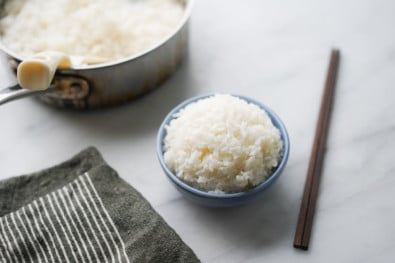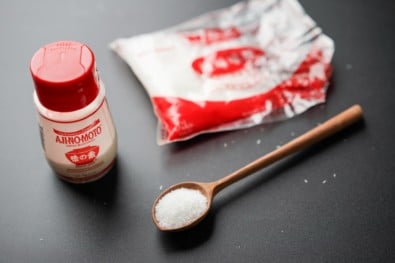Stock and broth are often used interchangeably in making soups and sauces, but they have slight differences. Stock is made from simmering roasted bones with vegetables.
Broth is made from simmering roasted or raw meaty bones and vegetables with added meat. Both stock and broth need to simmer for three to four hours. Bone broth is made just with roasted bones, but it needs to simmer for up to 48 hours.
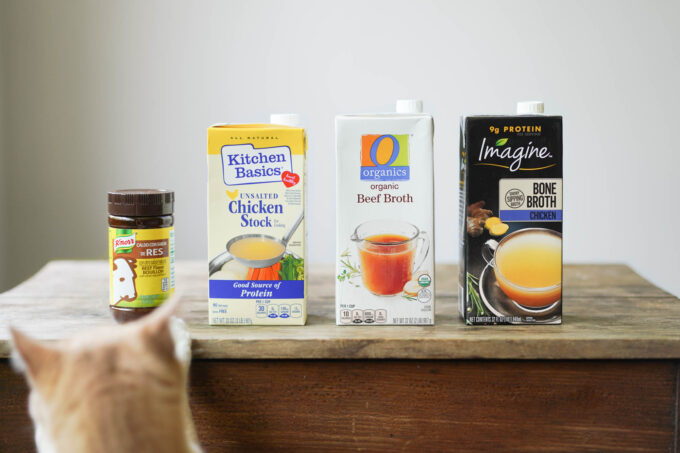
What is broth?
Broth can be used for soups and gravies, but unlike stock, it’s also meant to be sipped by itself. Broth is made the same way as stock, except you add raw meat and/or meaty bones (roasted is optional) with the vegetables to give it a meatier flavor.
To make a chicken broth, you could add a whole cut-up chicken to the pot. When the chicken is cooked, it’s removed and can be used for soup or salads. The broth needs to be skimmed and strained, but it doesn’t need to cool before you use it. You could serve it piping hot as is, or add in some of that chicken meat you’ve just cooked. It can also be refrigerated and the fat layer removed the next day.
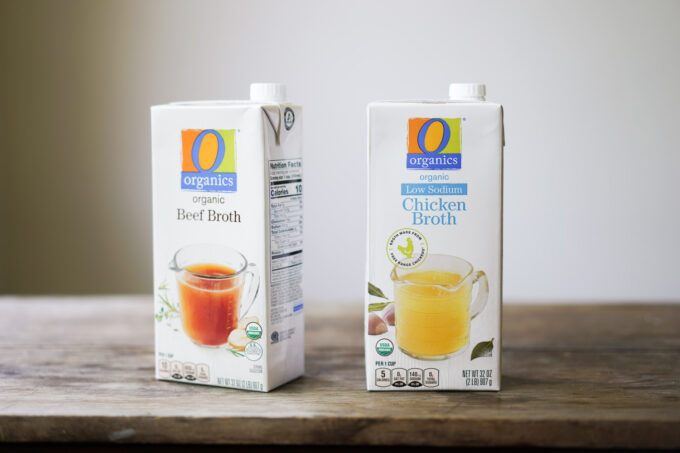
Stock and broth can be made from any meat bones and parts, but they vary in cooking times. Beef and veal bones need longer (four hours) to simmer than chicken bones do (two hours) before their gelatin is released; fish and vegetables need much less time.
All the soup recipes I’ve shared on my site are broths:
- Chicken Phở (chicken)
- Bún Bò Huế (beef & pork)
- Bún Riêu
- Bánh Canh Giò Heo (pork)
- Wonton Soup (chicken)
- Mì Khô Xá Xíu
- Miến Gà (chicken)
- Vietnamese Chicken Noodle Soup (chicken)
- Bún Thang (chicken)
What is stock?
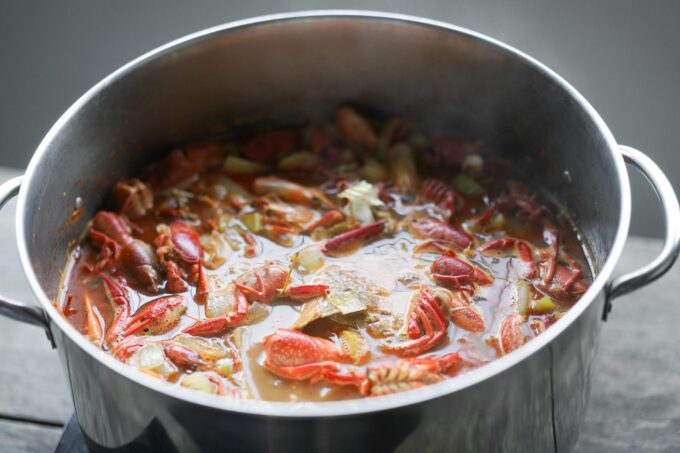
The main difference between stock and broth is that stock uses all bones or shells.
For most stock recipes, you’ll need 5 to 6 pounds of bones, which should be roasted first. Once roasted, the bones are simmered for several hours with aromatic vegetables — usually onion, carrot and celery. As the bones simmer, their gelatin is released, which gives the stock rich flavor.
The stock is then strained, and the bones and vegetables discarded. If you’re not using it immediately, allow it to cool completely then refrigerate it overnight. (Stock that hasn’t properly cooled turns sour when it’s refrigerated.) The next day, the fat will have solidified on the surface into a ¼- to ½-inch thick disk, which can be easily removed and discarded.
You could also save this rendered fat to use instead of oil or butter when you’re sauteing vegetables. In Jewish cooking, rendered chicken fat is called “schmaltz,” and it’s used in many recipes, such as chopped chicken liver, matzoh ball soup and even French fries.
Refrigerated stock will thicken to a Jello-like consistency. When reheated, the gelatin melts, and now you could turn it into a soup by adding meat and vegetables or use it as a base for a gravy.
What is bone broth?

Bone broth is always made with roasted bones and is prepared the same way as stock. The major difference between stock and bone broth is that that bone broth is simmered on very low heat for 24 – 48 hours. This slow-cooking not only releases gelatin but also adds calcium, collagen, glucosamine and other nutrients to the broth.
Bone broth is usually drunk hot and not used in cooking. Bone broth is reportedly beneficial for skin, bone strength, the digestive system and even improving sleep.
Can you substitute stock for broth?
Stock and broth are interchangeable in a recipe. In fact, you’ll often see stock or broth in the ingredient list. A couple of exceptions are for consommé, which only uses broth, and demi-glace, which only uses stock.
You shouldn’t substitute beef stock for a chicken recipe, since it will overwhelm the chicken’s flavor. But it’s possible to use chicken stock in a beef recipe, though it won’t have the same hearty flavor you want in a sauce or gravy for beef.
If you’re making soup, it’s always better to use the same type of stock or broth with the meat you’re cooking.
What about store-bought stock or broth?
Making homemade stock or broth from scratch is time-consuming and not very convenient. Fortunately it freezes well, so if you’re feeling ambitious, make a big pot and freeze it in ziploc bags. It usually lasts six months in the freezer with almost no loss in flavor when defrosted.
Store-bought stock or broth are a convenient alternative, though boxed definitely tastes more like the real thing than canned or bouillon cubes.
Boxed
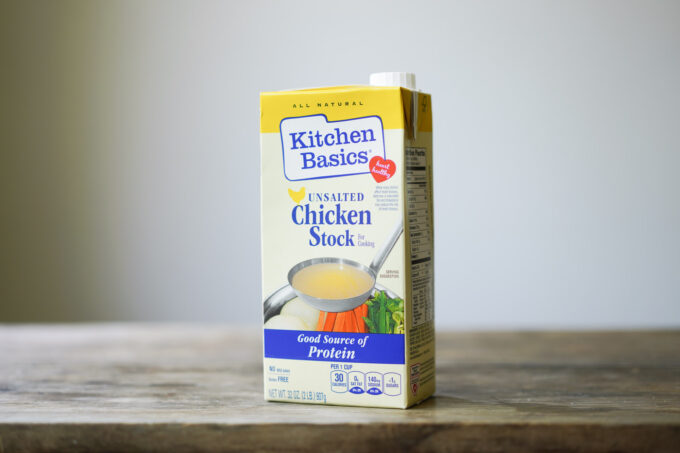
There’s no real difference in taste between boxed stock or broth. Boxed stock is usually loaded with salt, so choose one that is low sodium; you can then control how much salt is in the recipe.
Organic stock is slightly more expensive, but the meat with which it was made will be healthier and taste better.
Boxed stock is usually in one-quart packages, so unless you’re making soup, you’ll probably have left-over stock. It freezes well, and if it’s sealed in a ziploc bag, it can last for three to four months in the freezer with no loss of flavor. Past four months, however, when defrosted, it can taste watery.
Canned
Canned stock used to be the only stock you’d seen on supermarket shelves. Even Julia Child recommended using canned stock if homemade wasn’t available; however, she warned that canned stock can often have a metallic flavor, so she advised simmering it briefly with a carrot, celery stalk and onion.
Non-organic canned stock is plentiful and cheap, but again, for better flavor, choose the organic version. Canned stock can also have additives, like yeast extract, so read the label before buying it.
Canned stock comes in smaller quantities than boxed stock, usually in 14.5 ounce cans. If you have any left over, you can also freeze it for up to four months.
Bouillon cubes
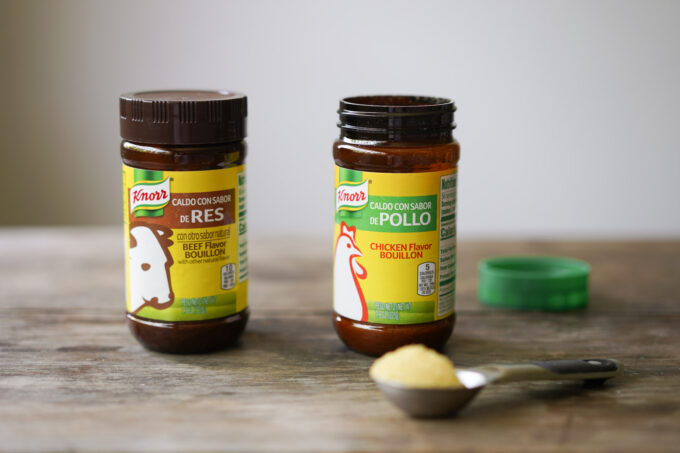
Once ubiquitous in kitchen pantries, if you’ve ever tasted a raw bouillon , then you know it’s like a chicken- or beef-flavored salt lick. Bouillon whether in powder or cube form, are made of dehydrated stock with salt, MSG and fat added.
Because of the fat, they can go rancid, but generally bouillon cubes have a shelf life of two years. If you’re really desperate, use them; otherwise go for boxed or canned.
How to make stock
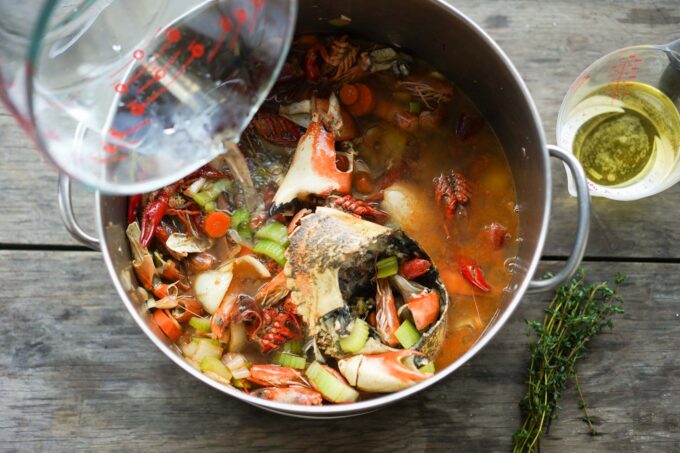
The richest tasting stock is one that begins with browned bones. The basic recipe will work with any type of meat bone. Julia Child always recommended saving trimmings and carcasses for stock by freezing them.
The bones and trimmings are all roasted in the oven until they’re well-browned. They’re drained of fat and oil, and then put into a stockpot with a large, unpeeled onion, two carrots and a stalk of celery. Add cold water to cover everything and bring to a simmer over medium heat.
Simmer for three hours, skimming the surface of the stock every 20 minutes to remove fat and foam. Strain it and use, or let it cool completely and refrigerate.
How to make broth
Broth needs meaty bones. Oxtails are a favorite for a beef broth, since they add extra gelatin. You could also use shank and knuckle bones (ask your butcher to chop them up).
Roasting the bones is optional. If roasted, drain them of fat and grease before adding them to the stockpot. As they simmer, skim the gray foam off the surface. After four hours, let the broth cool, and use tongs to lift out the large bones, and throw them away.
Strain the broth, retaining the meat but discarding the vegetables. You can add the meat back to the strained broth, or use it for another recipe, like a pasta sauce. The broth is ready to be sipped or cooled and refrigerated.






